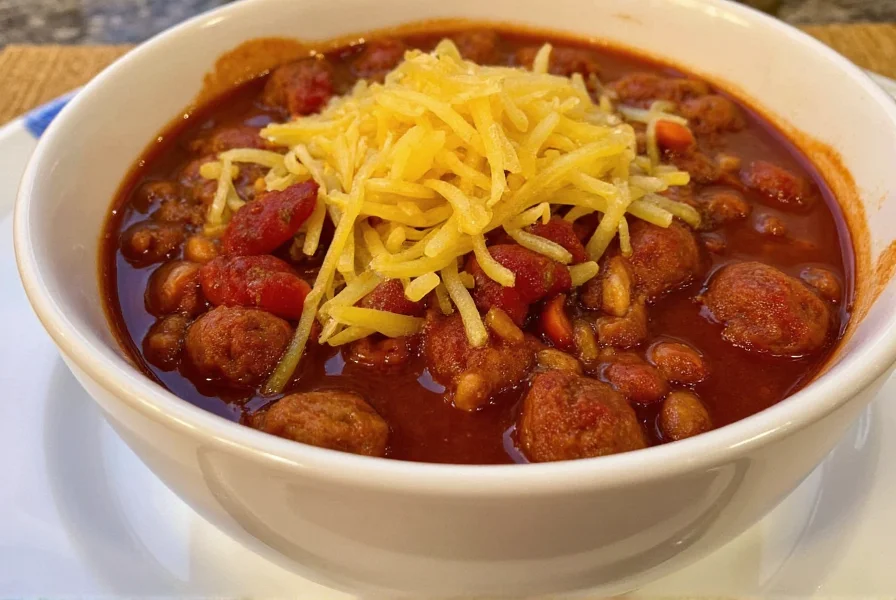Cincinnati chili confuses many first-time visitors expecting a bowl of hearty bean-and-meat stew. Instead, this Ohio specialty is a thin, aromatic meat sauce poured over spaghetti, creating a dish that’s equal parts comfort food and culinary curiosity. The secret lies in its distinctive spice profile—cinnamon, allspice, and cocoa powder—which sets it apart from any chili you’ve tasted before.
The Defining Characteristics of Cincinnati Chili
What makes Cincinnati chili truly unique isn't just its ingredients but how it’s served. Forget bowls—this regional specialty comes in specific combinations known as “ways,” each building on the previous:
- Two-way: Spaghetti topped with chili
- Three-way: Spaghetti, chili, and shredded cheddar cheese
- Four-way: Three-way plus either onions or beans
- Five-way: Spaghetti, chili, cheese, onions, and beans
Some establishments even offer specialty variations like the “cheese cone” (chili over a conical mound of spaghetti) or “hotter” versions with added cayenne pepper. The sauce itself has a distinctive sweet-spicy flavor profile that’s more reminiscent of Greek or Macedonian cuisine than traditional American chili.

Historical Origins and Cultural Significance
Cincinnati chili emerged in the 1920s when Macedonian and Greek immigrants adapted their native meat sauces to American ingredients. Tom Kiradjieff, a Macedonian immigrant, opened the first chili parlor—Cincinnati Chili—in 1922, later founding the Skyline Chili chain. These immigrants modified their traditional pastitsio sauce, creating something entirely new that would become central to Cincinnati’s food identity.
Unlike Texas chili, which emphasizes meat and heat, Cincinnati chili focuses on complex spices and specific serving methods. The dish spread through family-owned restaurants that maintained strict recipes, creating fierce local loyalty. Today, Skyline Chili and Gold Star Chili dominate the market, but dozens of independent parlors keep the tradition alive with their own interpretations.
Authentic Cincinnati Chili Recipe Components
Creating genuine Cincinnati-style chili requires understanding its distinctive components. Here’s what makes the sauce unique compared to other chili varieties:
| Component | Cincinnati Chili | Traditional Chili |
|---|---|---|
| Meat | Finely ground beef (sometimes mixed with pork) | Cubed or coarsely ground beef |
| Beans | Absent in the sauce (optional topping) | Common ingredient (kidney, pinto) |
| Spices | Cinnamon, allspice, cloves, cocoa powder | Cumin, chili powder, oregano |
| Texture | Thin, pourable sauce | Thick, stew-like consistency |
| Serving Style | Over spaghetti with specific “ways” | Served in bowls, often with cornbread |
The spice blend is Cincinnati chili’s defining feature. While exact recipes are closely guarded secrets, most versions include cinnamon, allspice, and sometimes a touch of chocolate or cocoa powder—ingredients that would seem unusual in Texas or New Mexico chili but create the distinctive flavor Cincinnati residents love.
Where to Experience Authentic Cincinnati Chili
For visitors wanting the genuine experience, Cincinnati offers dozens of chili parlors, each with subtle variations. Skyline Chili remains the most famous chain, but locals often debate whether Gold Star, Dixie Chili, or smaller independent spots serve the best version. When ordering, remember the “ways” system—first-timers typically start with a three-way (spaghetti, chili, and cheese) before progressing to more complex combinations.
Many Cincinnatians have strong loyalties to specific parlors, often based on family tradition. The city even hosts an annual chili festival celebrating this unique culinary tradition. For those unable to visit Ohio, several companies ship authentic Cincinnati chili mix nationwide, though purists argue nothing compares to eating it fresh in its hometown.
Common Misconceptions About Cincinnati Chili
Several myths surround this regional specialty. First, despite its name, Cincinnati chili bears little resemblance to chili con carne. Second, the dish isn’t particularly spicy—the “hot” version typically contains only mild cayenne pepper. Third, while cheese is essential to the classic preparation, it’s always cheddar, never the shredded Mexican blend some might expect.
Perhaps the biggest misconception is that Cincinnati chili represents Ohio’s statewide cuisine. In reality, it’s almost exclusively a Cincinnati phenomenon—residents of Cleveland or Columbus might never have tried it. This hyper-local nature makes it a perfect example of how American regional cuisines can vary dramatically within a single state.
Frequently Asked Questions About Cincinnati Chili
Why is Cincinnati chili served over spaghetti?
Cincinnati chili's spaghetti base reflects its immigrant origins. Greek and Macedonian immigrants adapted their traditional pastitsio—a baked pasta dish with meat sauce—using local ingredients. The spaghetti provided an inexpensive, familiar base for their spiced meat sauce, creating the unique combination that defines Cincinnati chili today.
Does authentic Cincinnati chili contain beans?
No, authentic Cincinnati chili sauce never contains beans. Beans are offered as a topping option (in four-way and five-way orders), but the sauce itself is strictly meat, spices, and liquid. This distinguishes it from many other chili varieties where beans are integral to the recipe.
What makes Cincinnati chili different from other chili styles?
Cincinnati chili differs from other styles in several key ways: its Mediterranean-inspired spice blend (cinnamon, allspice), thin consistency, absence of beans in the sauce, and unique serving method over spaghetti with specific topping combinations called “ways.” Unlike Texas chili which emphasizes meat and heat, Cincinnati chili focuses on complex, sweet-spiced flavors.
Can you make authentic Cincinnati chili outside of Cincinnati?
Yes, though achieving perfect authenticity can be challenging. The key is using the right spice blend (cinnamon, allspice, sometimes cocoa powder) and maintaining the thin consistency. Many Cincinnati chili restaurants sell their signature spice mixes online. While water chemistry differences might affect the final product slightly, dedicated home cooks can create remarkably authentic versions with proper ingredients and technique.
What are the most popular Cincinnati chili chains?
Skyline Chili and Gold Star Chili are the two largest Cincinnati chili chains, each with dozens of locations primarily in the Cincinnati area. Skyline is more widely recognized nationally, but Gold Star has equally passionate local followers. Other notable chains include Dixie Chili and LaRosa's Pizzeria (which serves its own distinctive version). Each chain has subtle variations in spice blend and preparation that fuel friendly local debates about which is “the best.”











 浙公网安备
33010002000092号
浙公网安备
33010002000092号 浙B2-20120091-4
浙B2-20120091-4